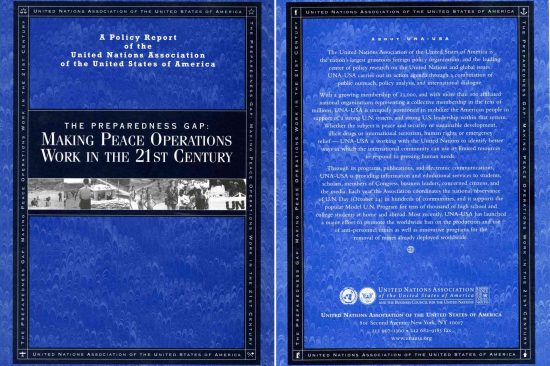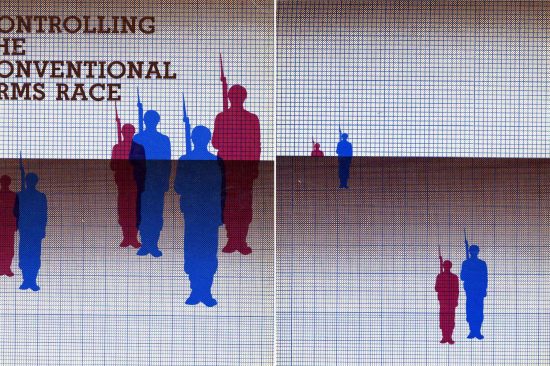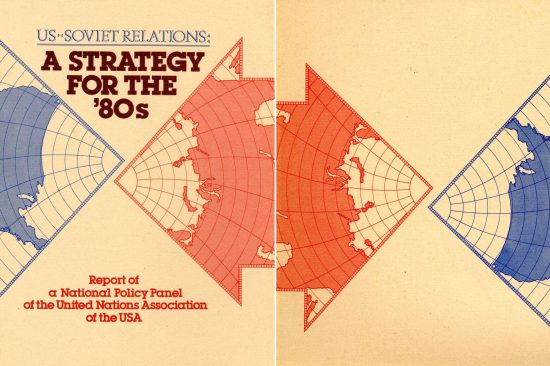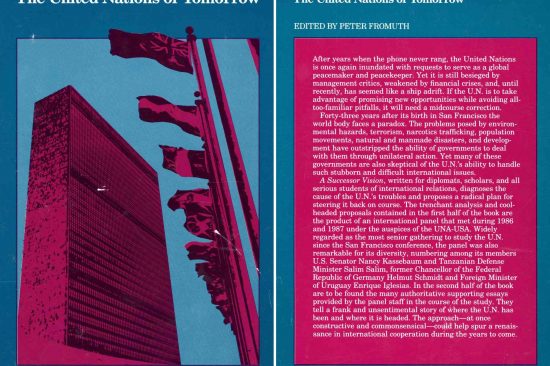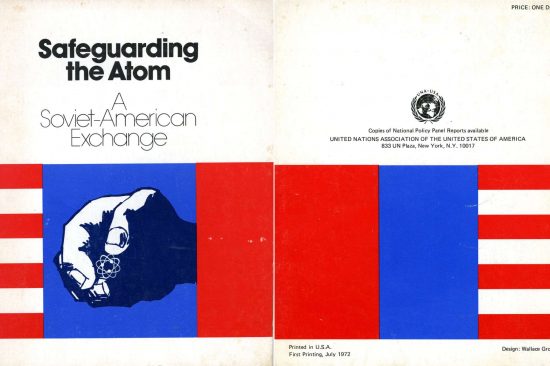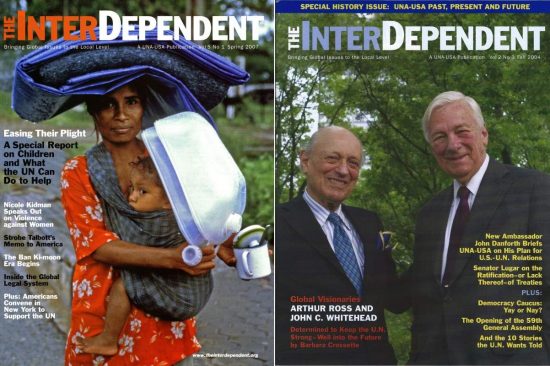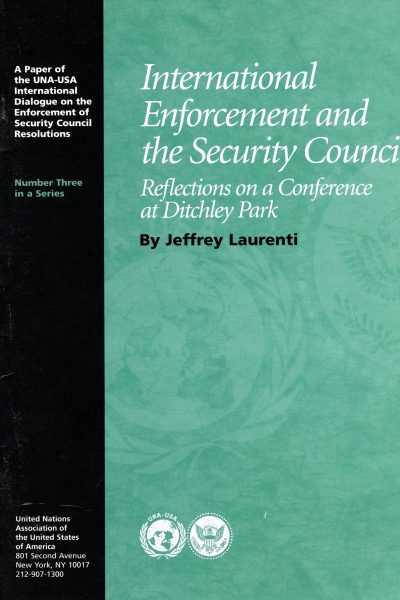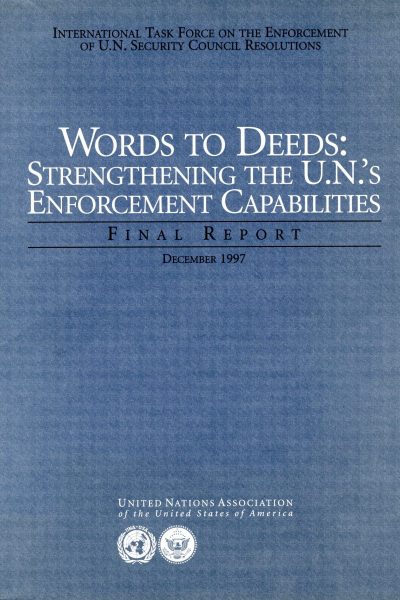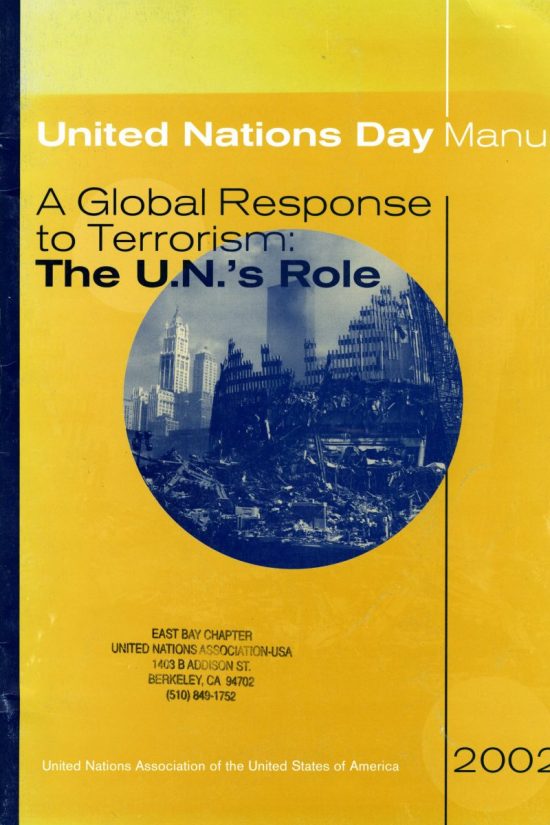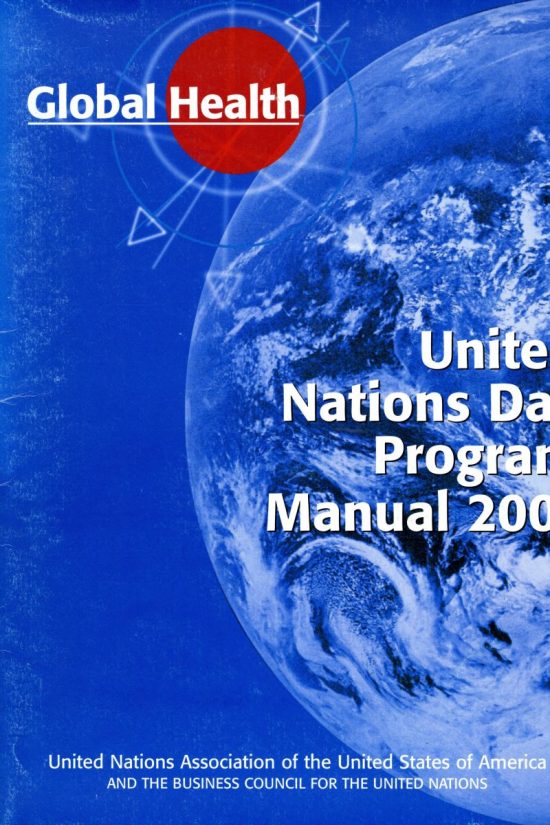This section presents a selection from the decades of studies reports, and periodicals produced by UNA-USA. Currently only the cover and a brief description of each document is on this site. None of these documents exist electronically. With the assistance of the Seton Hall University Archives, we will scan and post the full reports as resources permit.
-
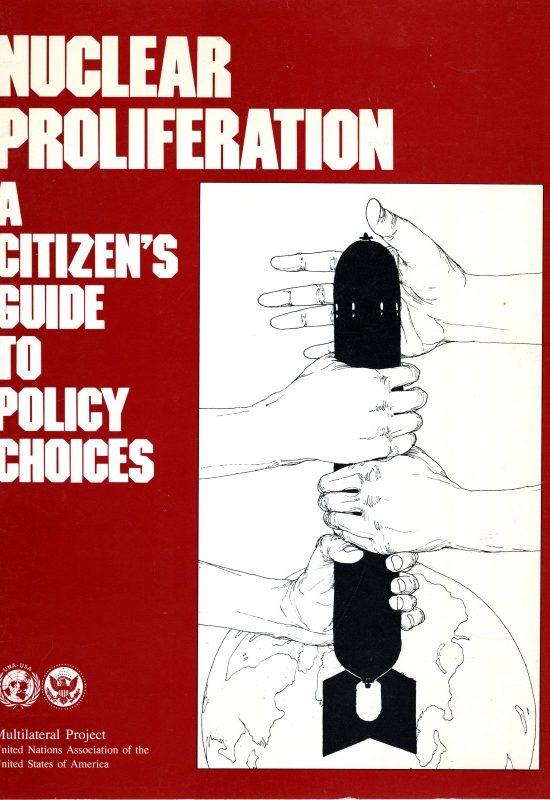
In 1984, the first Multilateral Project studies was titled “Nuclear Proliferation: A Citizen’s Guide to Policy Choices” and detailed the numerous nuclear proliferation issues facing the world at the time. The final report of the study, “Nuclear Proliferation: Toward Global Restraint,” proposed policy options on the subject ahead of the 1985 Review Conference for the Non-Proliferation Treaty.
-

“One Earth, Many Nations: The International System and Problems of the Global Environment” was published in 1990 and was the first collaboration between UNA-USA and the Sierra Club. The book explored issues entering the UN and public lexicon that are now daily concerns, like global warming, overfishing and sustainable development. The final publication, released later that year, was called “Uniting Nations for the Earth: An Environmental Agenda for the World Community.” Introduced on the 20th anniversary of Earth Day and ahead of the 1992 Earth Summit in Rio, the report was meant to stimulate debate among the US public on “what should be the direction of global environmental policy.”
-
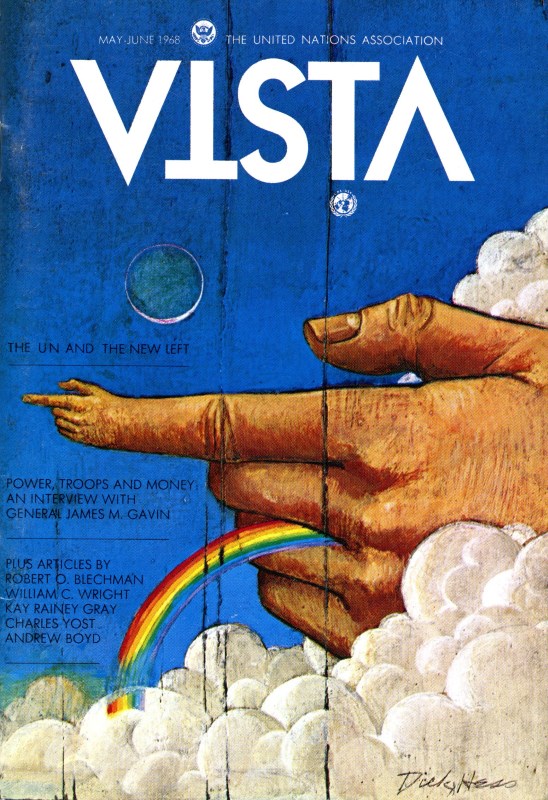
UNA-USA’s Vista magazine debuted in 1965, following the merger of AAUN and the US Committee for the UN. It replaced the magazine Changing World that the AAUN had published since the 1940s. Covering issues of importance to the United Nations and UNA, the magazine was notable its cutting edge covers and in-depth articles by some of the leading writers and diplomats of the day.
-
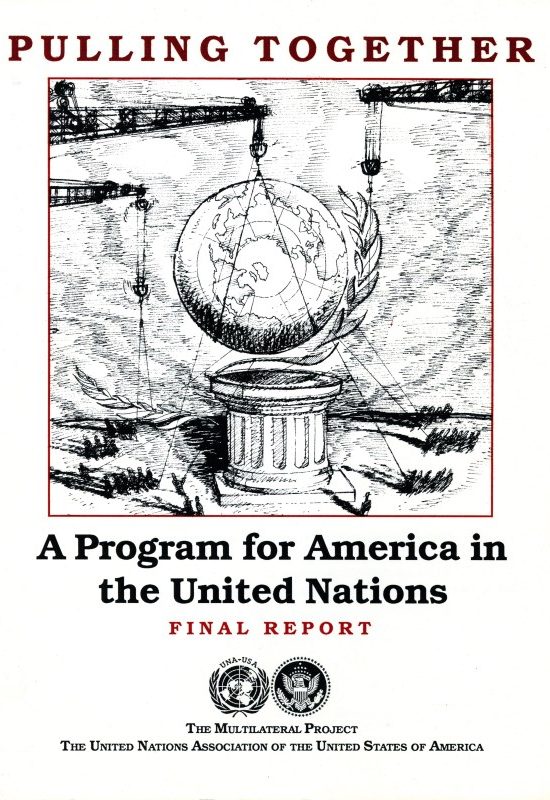
“Pulling Together: A Program for America in the United Nations” was published in 1988 and looked at a board range of issues relevant to the UN. The goal was to present the report to the new US president, but the report and its recommendations (election monitoring, controlling weapons of mass destruction, addressing AIDS and improving UN decision-making and management) gained additional relevance when the Cold War ended and the UN took on a larger role on the world stage.
-
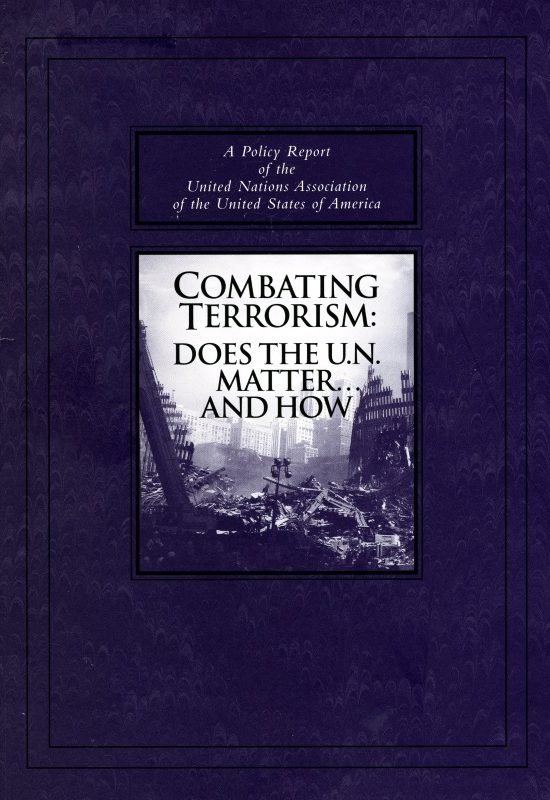
“Combating Terrorism: Does the UN Matter ... and How?” was a 2002 policy report – featuring the wreckage of the World Trade Center on the cover – tracking how the international community had already developed a body of treaty law to suppress specified terrorist acts regardless of political motive, even as a comprehensive definition remained stymied, and how new Security Council mandates on all member states to track terrorist funding and operatives were transforming international security.
-
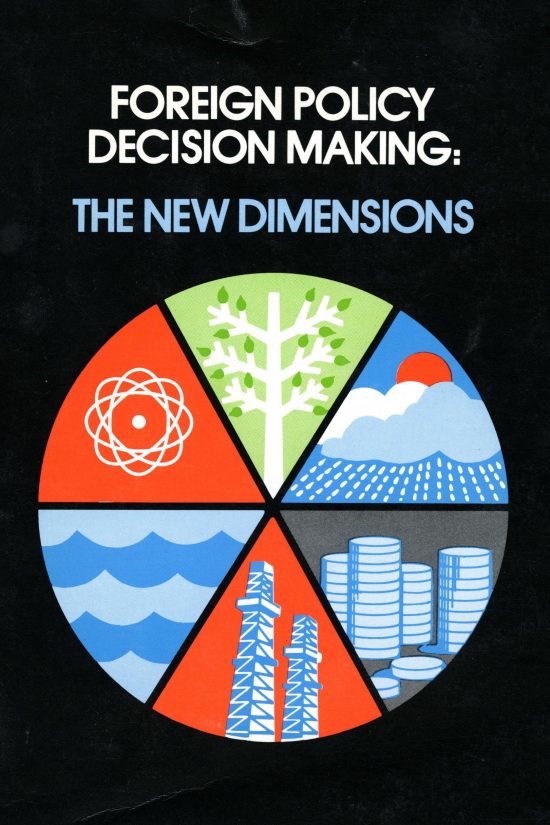
“Foreign Policy Decision Making: The New Dimensions” was published in 1973 in cooperation with the Carnegie Endowment for International Peace. In the preface written by future Secretary of State and future UNA Co-Chairman Cyrus Vance (who was the Chairman of the UNA-USA Policy Studies Committee) wrote that the report examined the “changed international setting” and “to see if improvements could be made in the U.S. decision-making process as it related to our participation in international organizations.” The study recommended that the President of the United States “give high priority to fostering and strengthening international institutions.”
-

“Beyond Normalization: Report of the UNA-USA National Policy Panel to Study U.S.-China Relations” examined how China’s changing policies could work to the benefit of both the United States and China. Published in 1979, the report said the two countries “have a strong interest in working out peaceful, constructive relations despite what both acknowledge to be substantial differences in the economic and political systems.” The report made recommendations in the fields of economics, security, technology, and culture.
-
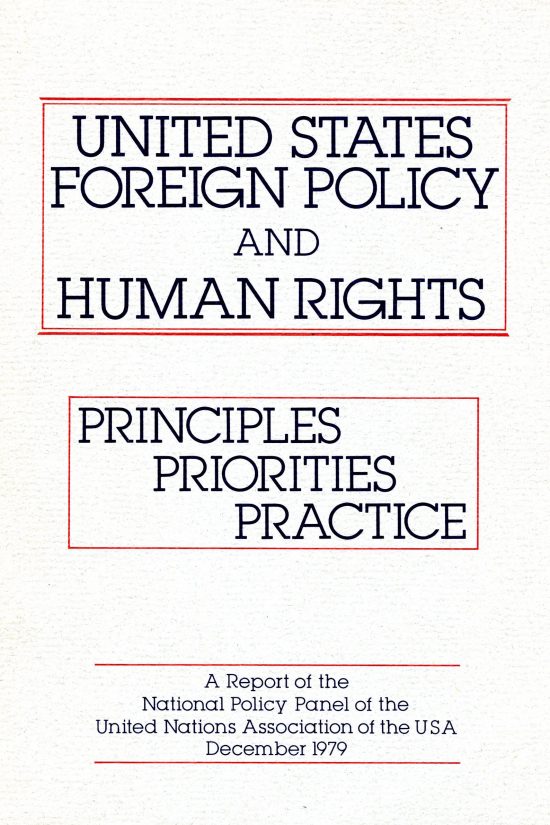
A report published in December 1979 called “United States Foreign Policy and Human Rights: Principles, Priorities, Practice” encouraged the US government to give a more important role to human rights in its multilateral and bilateral policies. The report said, “Reasons of morality, humanitarianism, the furtherance of peace and world order” require such initiatives and that a “primary” foreign policy goal should be to “further the acceptance of international human rights legal principles and institutions and of procedures to make the principles more enforceable.”
-

“The Future of US-China Relations,” edited by John Bryan Starr, was published in 1981. Written shortly after the beginning of the US-China Parallel Studies Program, the book examines US-China relations in terms of economics, security, technology, and culture and how each country relates to the Soviet Union, North and South Korea.
-

“The Japanese-American Alliance: A Framework for the Future” was a joint report by UNA-USA and the Asia Pacific Association of Japan in 1983. The first report resulting from the US-Japan Parallel Studies Program, the study warned that “the deep reservoir of goodwill” between the two countries was in danger and that they “can no longer afford to take each other, or their alliance, for granted.” The report called for greater cooperation in economic, security, foreign assistance, and diplomatic fields.
-

“The Next Giant Leap in Space: An Agenda for International Cooperation” was written in 1986. Written shortly after the Challenger disaster in January 1986, the report recommended that the United States regroup and work cooperatively with other countries to advance on key fronts in space exploration: the robotic exploration of Mars, and a space-based Global Change research program “to study the processes of environmental change on a global scale” to address the “disturbing evidence that human activities are creating major and potentially dangerous changes on Earth.”
-
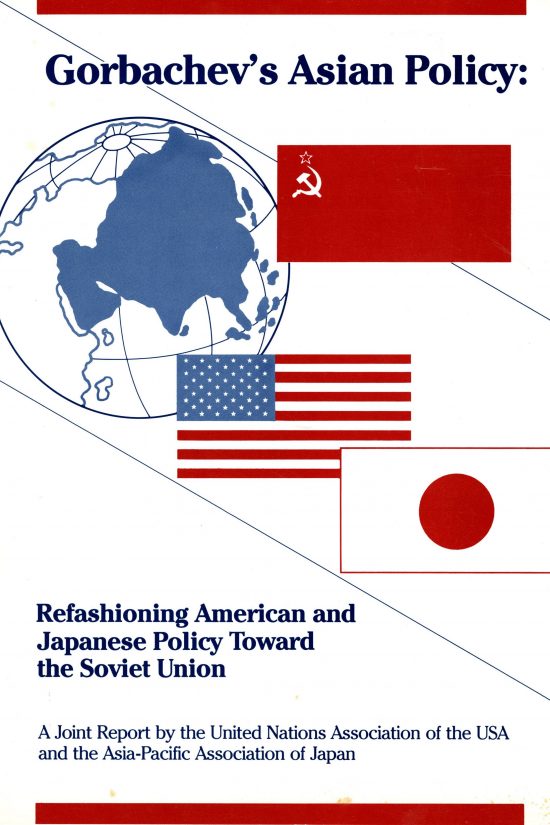
Seeking to understand the implication of the changes introduced by Soviet President Mikhail Gorbachev, UNA-USA and the Asia-Pacific Association of Japan published a joint report in March 1989 called “Gorbachev’s Asian Policy: Refashioning American and Japanese Policy Toward the Soviet Union.” Noting that Gorbachev intended to be more involved in the Asia-Pacific region, the report said Soviet power had to be viewed as much more than military might, but also as “new political thinking” on diplomatic and economic fronts. “During this time of rapid change,” the report said, “It is imperative that the United States and Japan reaffirm their common objectives while developing their respective policies” toward the Soviet Union.
-

“Common Goals: A Citizens’ Action Guide for U.S. Leadership at the United Nations” was designed to help UNA members to make their voices heard in US government’s decision-making. An initiative of the Multilateral Project of UNA-USA, the 1989 guide sought to capitalize on “a new spirit of cooperation at the United Nations” by translating that spirit “into energetic American policy.” The issues highlighted in the paper including human rights, drug abuse, the environment, conflict resolution (focusing on Afghanistan), labor standards, and UN structural reforms.
-
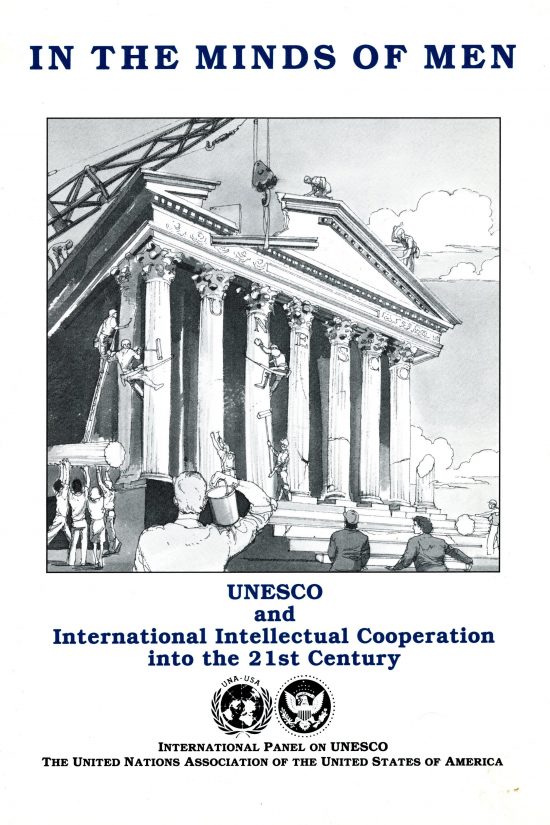
“In the Minds of Men: UNESCO and International Intellectual Cooperation into the 21st Century” was published in October 1989. The report argued for renewal of support for the organization (President Reagan had withdrawn the United States from UNESCO in 1984) saying “UNESCO’s primary role must be one of energizer and catalyst, a generator of ideas for concerted action.” It said there was “a process of renewal” underway at UNESCO “restoring some measure of confidence about the agency’s competence and potential effectiveness” and recommended several areas that merited special attention, including education, science, and human rights.
-
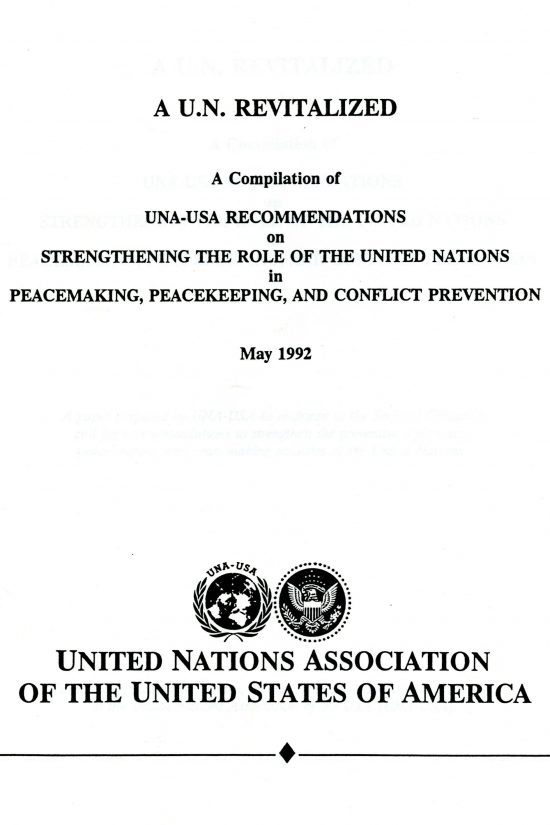
In response to a call by the UN Security Council for recommendations on strengthening preventive diplomacy, UNA-USA published "UN Revitalized: A Compilation of UNA-USA Recommendations on Strengthening the Role of the United Nations in Peacemaking, Peacekeeping, and Conflict Prevention.” The May 1992 paper was a collection of UNA’s relevant recommendations including making greater use of the Military Staff Committee, peacekeeping operations should be linked to settling the dispute, establishing a training center for senior military officers, and the creation of a “rapid deployment force.”
-
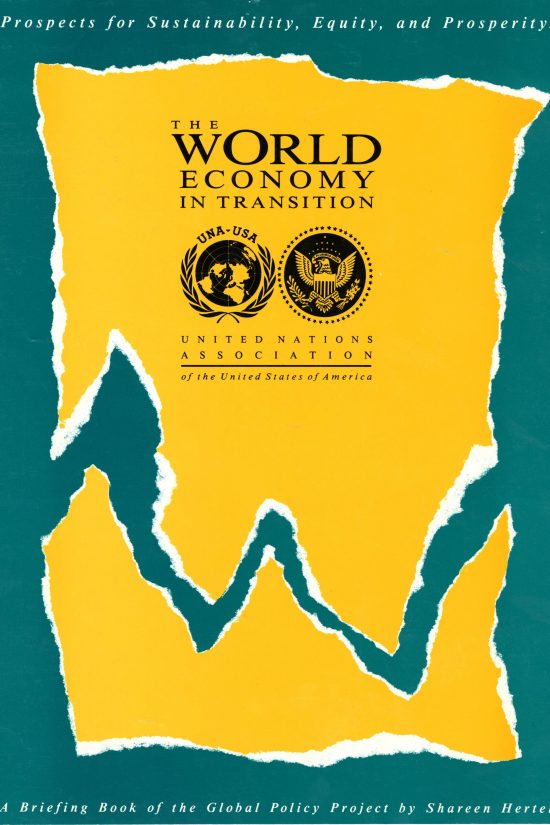
The 1993 briefing book, "The World Economy in Transition: Prospects for Sustainability, Equality, and Prosperity," was the basis for the report “A Consensus for Change: Transforming the United Nations’ Role in Global Economics.” The briefing paper said that Secretary-General Boutros-Ghali’s “An Agenda for Peace,” released the previous year, “articulated a bold vision of security,” in that “staving off military conflict” required not only military means but also by “promoting the political, social and economic conditions necessary to sustain peace.” To this end, the paper explored ways to use the Charter provisions and ECOSOC to promote “individual and collective freedom and sustaining peace through economic and social development.”
-
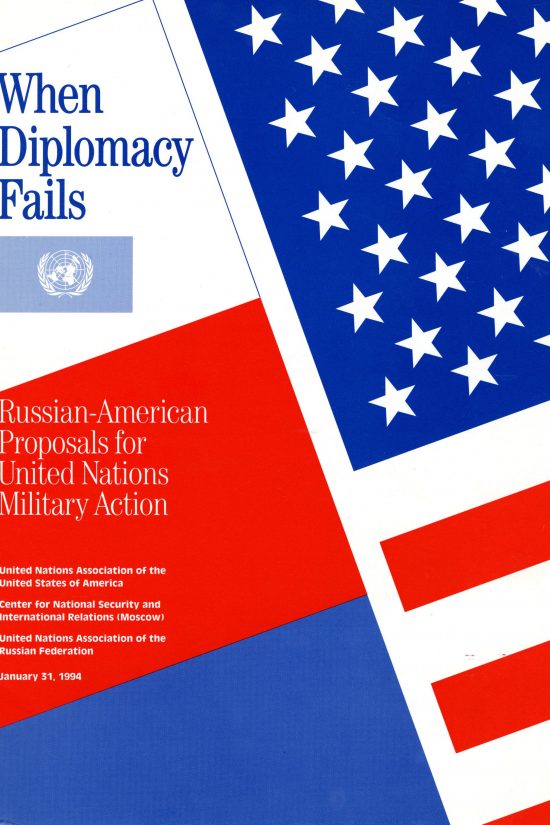
The January 1994 report “When Diplomacy Fails: Russian-American Proposals for United Nations Military Actions” was jointly produced by UNA-USA, UNA of the Russian Federation, and the Center for National Security and International Relations (Moscow). The report promoted a cooperative approach to strengthening the UN Security Council and the Military Staff Committee. Looking at conflicts including Somalia, the Persian Gulf, and Bosnia, the report said, “UN military capability needs to be strong enough and credible enough to provide an effective deterrent to would-be aggressors and adaptable enough to be employed in a wide range of contingencies.”
-
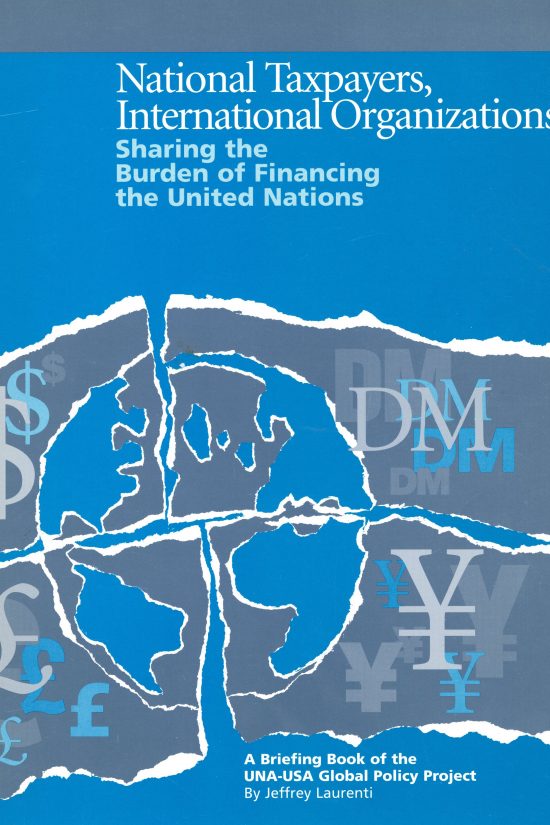
“National Taxpayers, International Organizations: Sharing the Burden of Financing the United Nations” was the briefing book of the Global Policy Project in 1995. In his forward, John C. Whitehead, the Chairman of UNA-USA, wrote that the report “was intended to spark spirited discussion on selected issues touching on national interests, international obligations, equitable burden-sharing, and political decision-making.” Those issues included how to handle “unfunded mandates” and how to assure financial security for the UN.
-
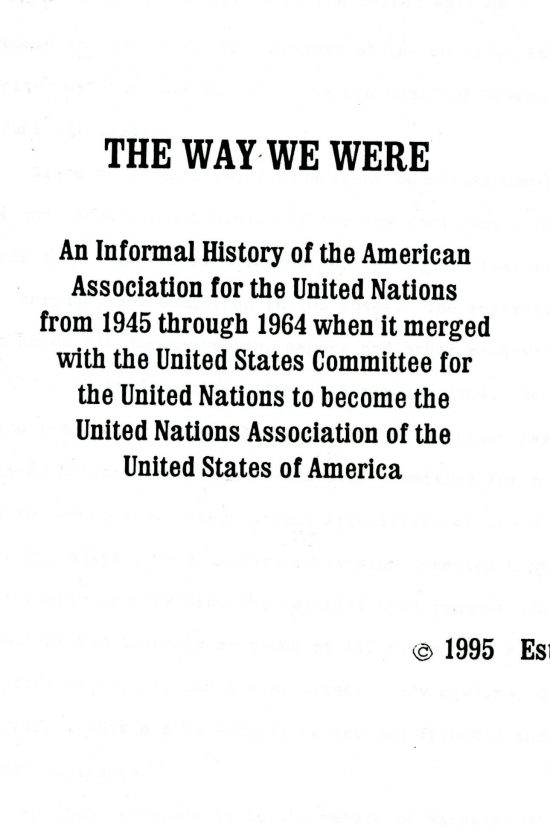
In 1995, Estelle Linzer, a long-time staff member of UNA, was asked to write an informal history of UNA-USA on the occasion of the UN’s 50th anniversary. Her manuscript, entitled “The Way We Were,” tracked the evolution of UNA from the San Francisco Conference of 1945 through personal recollections, newspaper clippings, and other reports. The manuscript was never published.
-
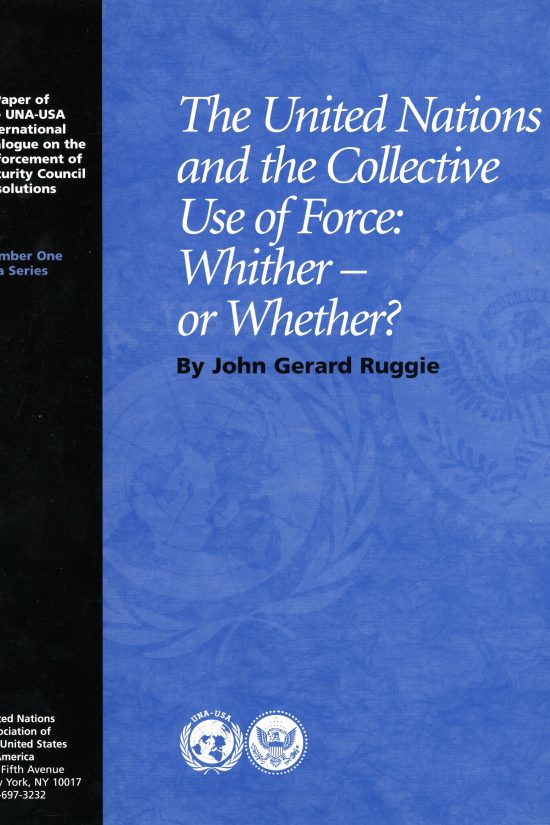
“The United Nations and the Collective Use of Force: Whither – or Whether?” by John G. Ruggie, the dean of the School of International Affairs at Columbia University and advisor to the UN Secretary-General. Published in June 1996, it tracks the evolution of the UN peace enforcement system and examined current issues including “doctrinal confusion exhibited by recent UN peace operations” and “the vexing issue of command-and-control.” The report was #1 in a series of papers by the UNA-USA International Dialogue on the Enforcement of Security Council Resolutions.
-

“The Application of the ‘NATO Model’ to United Nations Peace Support Operations Under the Security Council” by Gwyn Prins. The report examined the pros and cons of the Security Council adopting policies of NATO, meaning “the ways in which the UN can be drawn directly into forceful intervention.” The July 1996 report was #2 in a series of papers by the UNA-USA International Dialogue on the Enforcement of Security Council Resolutions.
-
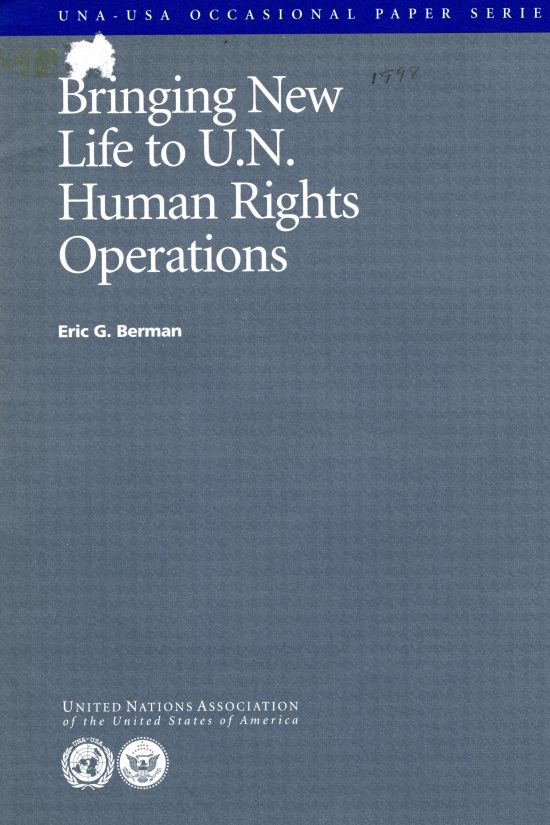
“Bringing New Life to UN Human Rights Operations” examined three UN human rights bodies: The Commission on Human Rights; The UN Center for Human Rights; and the UN High Commissioner for Human Rights. Published in 1998, this Occasional Paper recommended that a two-track approach of reforming these entities while “integrating human rights into all UN activities” offered “the greatest potential for progress in implementing existing human rights standards.”
-
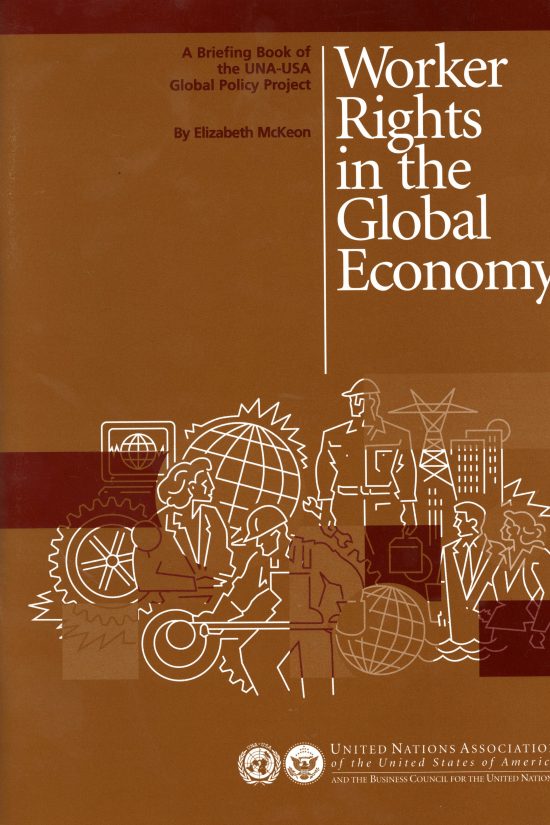
The 1999 briefing book, entitled "Worker Rights in the Global Economy," looked at the impact of globalization was having on labor rights, business, trade, and the International Labor Organization. The paper noted that “the line between ‘domestic’ and ‘foreign’ policy is increasingly blurred,” thus UNA felt the need to help US citizens reach out to “their counterparts in other countries about ways to solve the problems that affect us all.” No final report followed this briefing book.
-

UNA-USA chapters operated both autonomously and in a coordinated fashion. UNA regular published an “Advocacy Guide: How to Make Your UNA-USA Chapter an Effective Proponent for the United Nations.” The purpose of the Guide was to offer advice to chapter members on issues such as building membership, developing a media strategy, legislative advocacy, and hosting candidate forums. This example is from April 2002.
-

“UNtold Story: Working for Children’s Health” was published to commemorate the 100th anniversary of the Pan-American Health Organization in 2002. The project’s goals included promoting “global interdependence” as “essential components” for stability and prosperity, increasing US engagement in UN efforts, and publicizing successful initiatives in children’s health. Issues included vaccinations, mother-to-child transmission, and infant mortality.
-
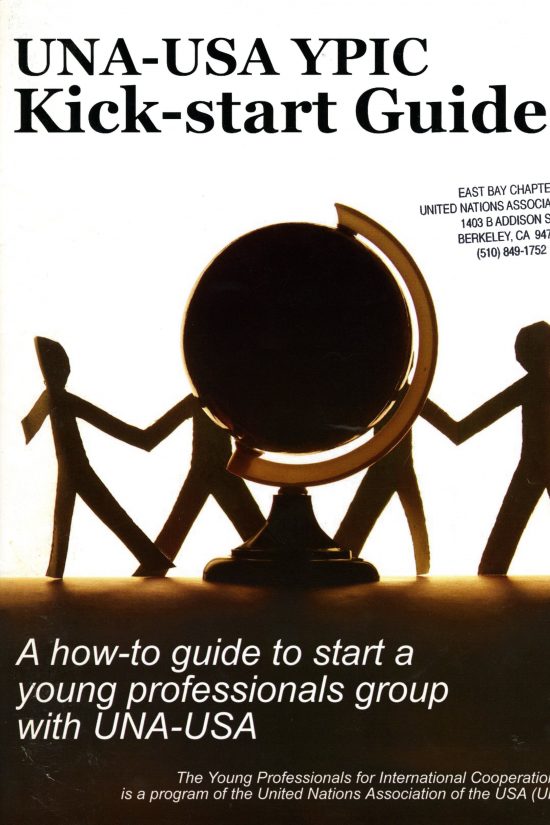
The Young Professionals for International Cooperation (YPIC) was a program of UNA-USA that sought “to engage young professionals to promote effective US involvement in international affairs” and in the UN. “UNA-USA YPIC Kick-start Guide: A how-to guide to start a young professionals group with UNA-USA” was a primer to introduce people to YPIC, UNA, and the United Nations. A major focus was on how to build a YPIC chapter. This report is from 2006.
-

“The Global Connection: New International Approaches for Controlling Narcotic Drugs” was the 1991 report of the Global Policy Project. The results of US “various control efforts have been uneven, apparently owing as much to the broader social currents as to the effectiveness of the law enforcement apparatus,” wrote John C. Whitehead, Chair UNA-USA, in the preface, “The United Nations system has long played a key role in the international effort to prevent drug abuse.” He added, “We thought this was a propitious time to engage the American public in the debate over international narcotics policy.”
-
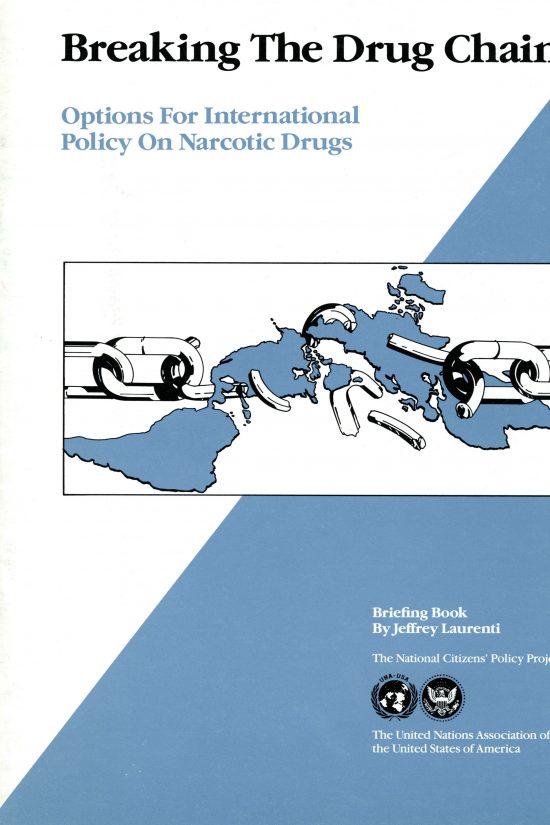
“Breaking the Drug Chain: Options for International Policy on Narcotic Drugs” was the briefing book that preceded the report. In the foreword by Rep. Charles Rangel, the Chairman of the US House Select Committee on Narcotics Abuse and Control wrote that as the world “has begun to mobilize against the newest drug dangers … Already new legal machinery is emerging … and an impressive consensus has formed on a broad global program of action.”
-

“Inalienable Rights, Fundamental Freedoms: A UN Agenda for Advancing Human Rights in the World Community,” was published in 1996 by a national advisory committee led by former Oregon representative Les AuCoin. John Whitehead, the chairman of UNA, wrote that the report “makes a major contribution in locating international human rights policy in a context of America’s own remarkable social history of democratic enlargement.” The paper made many recommendations for strengthening existing human-rights instruments and for enacting new ones, including the much-anticipated International Criminal Court.
-
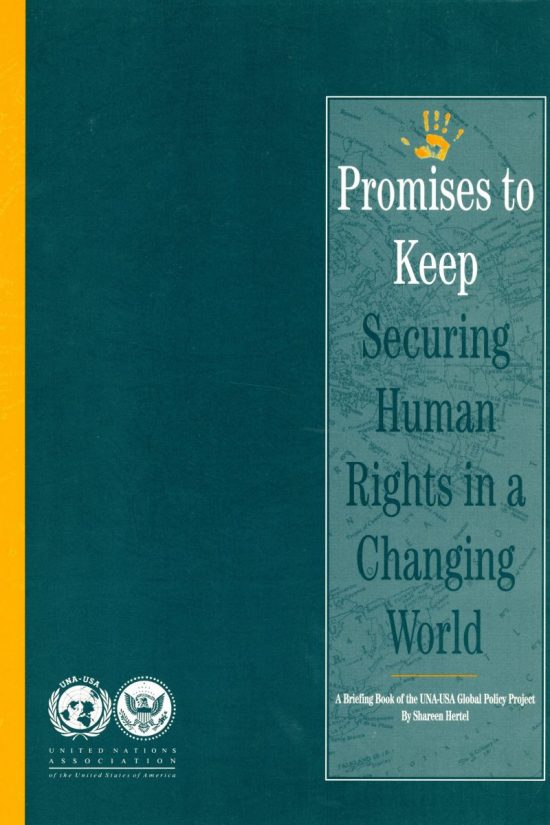
The briefing book “Promises to Keep: Securing Human Rights in a Changing World,” explored how the evolving definitions and understandings of human rights could take a more comprehensive approach in UN work.
-
![The Preparedness Gap: Making Peace Operations Work in the 21st Century]()
“The Preparedness Gap: Making Peace Operations Work in the 21st Century” was published in 2001. It looked at how the UN could improve its peacekeeping and peace-building capacities and how the US could aid in this campaign. The recommendations for the UN included the creation of a rapid deployment force, a “reserve police capacity,” a standby “civil administrator corps,” a unity of command and “a clear assignment of responsibilities.” UNA also called on Washington to encourage military and police personnel to train for UN missions, provide up-to-date matériel and promptly pay the money owed to the UN for peacekeeping and regular budget contributions.
-
![A Policy Report on the Partnership Program on Peace-Building and Rule of Law]()
UNA conducted a joint venture with Harvard University called the Project on Justice in Times of Transition at Harvard University (since renamed Beyond Conflict). Its 2003 report, “A Policy Report on the Partnership Program on Peace-Building and Rule of Law,” had two goals: “heightening awareness in the policy community on the importance of establishing the rule of law to the success of international peace and stability operations” and “generating fresh recommendations” on how the UN and other multilateral institutions “can improve their capacity to support the establishment of the rule of law in post-conflict societies.” Working with the UN Secretariat, the project conducted regional workshops in Singapore, Botswana, Istanbul and New York.
-
![Acts of Nature]()
“Acts of Nature, Acts of Man: The Global Response to Natural Disasters” was published in June 1977. In his preface, the Chairman of the UNA-USA Policy Studies Committee, Robert V. Roosa, wrote that “the size and frequency of relief operations are posing more and more difficult managerial and legal questions for the international community” as “large regions of the globe are becoming increasingly vulnerable to natural disasters.” The report made a series of recommendations for improving disaster relief and response to the US government, the International Committee of the Red Cross, and UN agencies including the World Food Program.
-
![Conventional Arms]()
“Controlling the Conventional Arms Race” sought to focus on an issue overshadowed by the nuclear arms race. In this 1976 report, Robert S. Benjamin, the Chairman of the UNA-USA Board of Governors, wrote that the report showed “conventional arms control presents a promising new agenda for international negotiations and that it is time to launch parallel efforts to limit conventional and nuclear weapons.”
-
![Strategy for the 80s]()
Published in 1981 at the start of the Reagan administration, “US-Soviet Relations: A Strategy for the 80s” was a product of the UNA-USA National Policy Panel on US-Soviet Relations. Examining Us and Soviet interactions on a broad range of issues including arms control, economic competition, human rights, and “societal values,” the report said there is “one inescapable conclusion: the US and USSR cannot hope to be partners and cannot afford to be enemies… The challenge to both Moscow and Washington will be to strike a balance – an uneasy coexistence of competitive forces – that is sustainable over the long haul.”
-
![Successor Vision]()
“A Successor Vision: The United Nations of Tomorrow” was a 1988 book edited by Peter Fromuth. The book, “written for diplomats, scholars, and all serious students of international relations, diagnoses the cause of the UN’s troubles and proposes a radical plan for steering it back on course.” A project of the UN Management and Decision-Making Project, the book proposed policy reforms on issues including arms control and disarmament, disaster management, the role of the Secretary-General, and financial decision-making in the UN .
-
![Safeguarding The Atom]()
“Safeguarding the Atom: A Soviet-American Exchange,” published in 1971, contained two reports: one from the UNA-USA and one from the UNA in the USSR. Both reports presented perspectives on nuclear non-proliferation issues including strengthening the nuclear Non-Proliferation Treaty, negotiations on nuclear arms reductions, and related issues such as security guarantees for non-nuclear weapon states.
-
![The InterDependent]()
The InterDependent replaced Vista in 1975. At first largely a “house organ” for the UNA, it evolved into a blend of UN-related news, interviews and profiles along with inside information about the UN and UNA designed to keep UNA members informed across the board. In the early 2000s, the InterDependent changed to a glossy format. By 2010, because of UNA’s financial problems and a general decline in the magazine business, the InterDependent ceased publishing a print version and went digital instead.
-
![Vista: The UN at 25]()
To commemorate the 25th anniversary of the United Nations in 1970, UNA published "Vista: The UN at 25." This book-length version of UNA’s monthly magazine included essays by leaders such as UN Secretary-General U Thant, New York Governor Nelson Rockefeller, New York City Mayor John Lindsay, and Robert Benjamin, the Chairman of the UNA-USA Board of Governors. Forward-looking features covered arms control, human rights, technology, and the work of specialized agencies.
-
![Worker Rights]()
“International Workers Rights: A Human Face for the Global Economy” was a November 1999 publication of the UNA of the National Capital Area (UNA-NCA). Written as a contribution to the NCA’s Task Force on Worker Rights in the Global Economy, the paper said, “It is reasonable and moral to believe that more effective protection and promotion of human rights and worker rights will make the world a better place.” The report outlined ways to promote worker rights in the global economy and compiled a number of relevant documents including declarations by the International Labor Organization.
1992 Global Policy Project
The project sought to apply the lessons from the Gulf War to the need for peacekeeping and enforcement to the broader international community. A briefing book - "The Common Defense: Peace and Security in a Changing World" – and a final report – “Partners for Peace: Strengthening Collective Security for the 21st Century” – were written around the concept that “suddenly, it seemed possible to realize the vision of collective security,” as John Whitehead, the chairman of UNA, wrote in “The Common Defense.”
Peacekeeping – which was expanding in the number of missions and their mandates – was a focus of the study, but the interlocking issues of peace-enforcing, peace-building and initiatives to integrate international law, economic development and arms control and disarmament were all woven into a comprehensive vision. “The UN framework for collective security founded on law once again becomes a viable one,” wrote Jeff Laurenti, the Executive Director of the Project.
The International Task Force on the Enforcement of UN Security Council Resolutions
The International Task Force on the Enforcement of UN Security Council Resolutions, begun in 1995, consisted of a series of dialogues and research papers. Lord Carrington, the former British foreign secretary and secretary-general of NATO, served as chairman. “Recognizing both the weaknesses of existing international enforcement machinery and the reluctance of many UN member states to grapple seriously” with enforcing Council resolutions, UNA convened the task force “to consider fresh approaches to this longstanding dilemma.”
UN Day Publications
Every year UNA-USA held a program on UN Day focusing on a particular theme relevant to the UN and of interest to UNA members. “Global Health: United Nations Day Program Manual 2001” was the publication for that year. The paper, written with the Business Council for the United Nations, examined both health issues affecting the world, including HIV/AIDS and malaria, and how UNA members could mobilize the public to engage on these issues.
In 2002, the theme of the manual was “A Global Response to Terrorism: The UN’s Role.” In reaction to the terror attacks of September 11, 2001, the document examined out the UN system could play a more activist role in combatting terrorism and how the United States could work more collaboratively with the UN, in particular the Security Council.
Gulf Crisis
“The United Nations in the Gulf Crisis and Options for U.S. Policy” by David J. Scheffer, an international lawyer and future UNA vice president. The October 1990 report (revised February 1991) was written after the UN Security Council imposed sanctions on Iraq following its invasion of Kuwait (August 1990) and before the US-led coalition’s invasion (January 1991), the paper explores how the Security Council (and the UN in general) could promote collective self-defense, enforce sanctions, and aid refugees. It also looked at the long-term issues of restoring Kuwait’s sovereignty and improving stability in the Middle East. This report was Report #1 in the UNA-USA Occasional Papers series.
Other Occasional Papers Were:
“Washington and the World: Organizing Economic Cooperation in an Age of Global Competition” (#2, November 1990)“Roles for the United Nations After the Gulf War” (#3, February 1991)
“Making UNCED Work: Building the Legal and Institutional Framework for Sustainable Development at the Earth Summit and Beyond” (#4, March 1992)
“Enhancing the Capacity of the United Nations in Maintaining Peace and International Security: A Common Interest of Japan and the United States" (#5, May 1992)
“American Public Opinion and the United Nations, 1992: Evolving Perceptions of a Changing World” (#6, May 1992)
“Institutionalizing the Earth Summit: The United Nations Commission on Sustainable Development” (#7, October 1992)
“Curbing the Middle East Arms Race: Policy Options for the United States and United Nations” (#8, December 1992)

